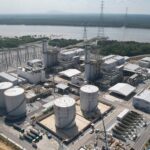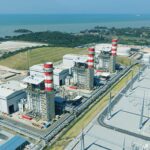General Electric (GE) will provide two of the company’s 9HA.01 gas turbines along with other equipment and services to a new power plant in Malaysia. The company on March 24 announced it secured an order from a consortium of three groups, including Mitsubishi Corp., that is serving as the engineering, procurement, and construction (EPC) lead for the project.
The 1.2-GW Pulau Indah Power Plant is sited in Selangor, Malaysia. The two-block combined cycle plant will feature a modular configuration, according to GE. It also will include an STF-D650 steam turbine, a W88 generator, and a once-through heat recovery steam generator (HRSG). GE said the “HRSG technology is a key enabler in advanced water-steam cycles delivering higher combined cycle efficiency, while GE’s 9HA is the company’s flagship and most efficient 50 Hz gas turbine.”

The gas-fired facility is scheduled to enter commercial operation in 2024. The EPC consortium includes Posco Engineering & Construction Co. Ltd. (POSCO), and PEC Powercon Sdn. Bhd, in addition to Mitsubishi. Dallas, Texas-based Jacobs, a technical consultancy, recently was chosen to deliver owner’s engineer services for the project.
GE recently debuted its 9HA.02 gas turbine at a 1.4-GW plant in Malaysia.
Emissions Reduction Plan
GE said the efficiency of the new equipment can exceed 63%, based on International Standards Organization (ISO) conditions. It is being built to conform with Malaysia’s Intended Nationally Determined Contribution (INDC) Plan, which supports emission reduction goals.
“Malaysia in particularly the state of Selangor has seen massive economic development, urbanization and population growth in the last three decades, which have been major drivers for its increasing demand for energy, although accompanied with increasing greenhouse gas emissions,” said Datin Paduka Norazlina Zakaria, executive director of Pulau Indah Power Plant Sdn. Bhd. (PIPP), in a statement Wednesday. “It was crucial for us to select a highly efficient technology, like GE’s 9HA.01, to help reduce the amount of fuel used to generate electricity, and working with GE to provide services and cost-effective performance improvements on the power generation equipment will help us achieve our goals.”
Malaysia’s INDC Plan was adopted in 2015, ahead of the Paris climate accord. Key elements of the plan include a goal of reducing “the greenhouse gas (GHG) emissions’ intensity of the country’s gross domestic product (GDP) by 45% by 2030, relative to the emissions intensity of GDP in 2005.” That figure includes a 35% reduction “on an unconditional basis and a further 10% is condition upon receipt of climate finance, technology transfer and capacity building from developed countries,” according to the plan.
Improved Efficiency
Government officials have acknowledged the difficulty that growing economies can have in reducing GHG emissions, since economic development brings more industrial activity and energy use. Malaysian officials have specifically said improving the efficiency of electricity generation in the country’s thermal power plants is critical to achieving climate goals.
“We are proud to be a part of this exciting project. We bring more than 80 years of equipment production for gas power plants to [the] Pulau Indah Power Plant project,” said Ramesh Singaram, president and CEO of GE Gas Power Asia. “The 9HA gas turbine at its core was engineered from the ground up to be extremely efficient and flexible to help lower emissions. This includes high ramp rates and fast start-up times to meet fluctuating demand, and the capability to burn up to 50% by volume of hydrogen when blended with natural gas. We see continued efficiency gains in the years to come.”
GE for this project signed a 21-year services agreement with PIPP. That group was created as a “special purpose vehicle” by “two prominent shareholders, namely Worldwide Holdings Berhad and Korea Electric Power Corporation (KEPCO),” according to a news release. Worldwide Holdings Berhad is part of Selangor State Development Corp., a government-owned entity, and owns 75% of PIPP. KEPCO, South Korea’s largest electric utility, owns the remaining 25%.
Dae-Gyun Kim, project director for POSCO, in a statement about the contract with GE said, “With the Pulau Indah Power Plant, we looked across the industry seeking equipment that met strict standards that included proven technology, plant performance, maintainability, operational flexibility, environmental impacts, footprint, lifecycle costs and more.” Kim said GE’s equipment will enable “a total plant configuration that is simple and cost-effective to install, control and maintain. We are confident that the standard configuration packages and plant modularization will help a faster project execution.”
GE said its services contract includes planned maintenance for capital parts, along with major inspections of the 9HA.01 gas turbines, and any repairs. It also includes technical advisory services. GE said it will monitor plant performance with its integrated Mark VIe Distributed Control System, which is utilized across its system “for programming, configuration, trending, and analyzing diagnostics.” Data collected from sensors at the Malaysian plant will be monitored and analyzed at GE’s Monitoring & Diagnostics Center in Atlanta, Georgia.
—Darrell Proctor is associate editor for POWER (@POWERmagazine).










